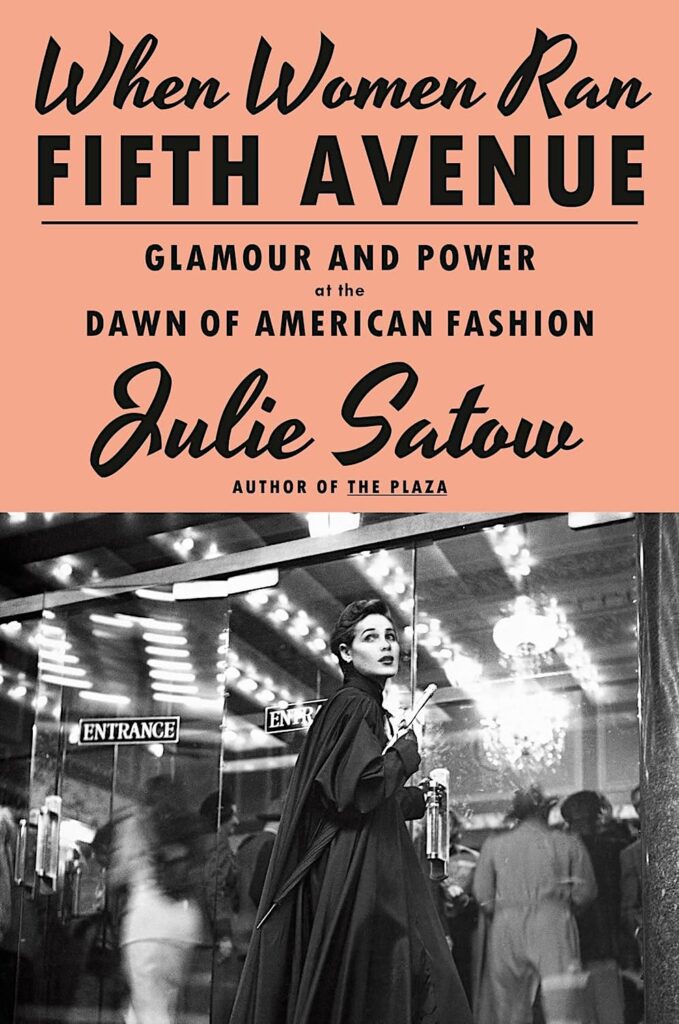Kitty Kelley Book Club: ‘When Women Ran Fifth Avenue: Glamour and Power at the Dawn of American Fashion’
By • September 11, 2024 0 1586

A tour-de-force look at the doyennes of designer couture.
Given that women are the biggest buyers of books in America, and that the country boasts the largest apparel market in the world ($312.4 billion between 1992 and 2022), a book about women in fashion is bound to be a best-seller for Julie Satow, who ingeniously spotlights the three female moguls who ruled Fifth Avenue fashion in the 20th century.
With style and sass, Satow tells the story of the trio who revolutionized retail at Bonwit Teller, Lord & Taylor, and Henri Bendel. Each of those plate-glass palaces, late and lamented, reigned as cathedrals to the carriage trade. While all three were purchased by men, each blossomed into profit and prestige under women. Satow unspools their stories of success with polish and panache, writing of an era in which department stores were consumer wonderlands and rich emporiums of luxurious goods.
Satow begins “When Women Ran Fifth Avenue” at the height of the Depression, with Hortense Odlum arriving at Bonwit Teller wrapped in fur as she steps from her chauffeured limousine to enter the Art Deco skyscraper now owned by her husband, Floyd, president of Atlas Corporation. Unbeknownst to Hortense, 41, her husband had fallen in love with the young woman behind the perfume counter; but he decided his wife, who’d never worked but always shopped, could transform Bonwit’s, then bordering on bankruptcy.
“Just take a look and tell me what you think,” said Floyd. “Figure out why women don’t shop there anymore.”
Hortense accepted the challenge. She took a look, made a few suggestions and, thinking the corner office and title of president would only be temporary, began rearranging the boutiques and salons. She had every department painted and redecorated and, most important, started relating to customers as “high class, but not high hat.” The 26-year-old behind the perfume counter ended up marrying Floyd, who financed her career as a pilot. Hortense, meanwhile, became the first female titan on Fifth Avenue, a position she held for six years before abruptly retiring, embittered by the price she’d paid for her professional success. “I worked like a Trojan. But I never intended to stay,” she remarked. “I’m out now and the whole thing leaves me cold.”
The real Trojan, who thrived on the 24/7 work and pressure of retail business, was Dorothy Shaver of Mena, Arkansas, who devoted her life to the job from 1921 until the day she died in 1959. Shaver became president of Lord & Taylor and, writes Satow, “Fifth Avenue’s First Lady.” By the time of her death, Shaver, who never married and lived with her sister, had rocketed store sales to $100 million a year and was revered throughout society.
Shaver’s death at the age of 66 made the front page of the New York Times, which hailed the “First woman ever elected to head a large retail corporation when she became president of Lord & Taylor.” Such was her standing that the paper’s publisher, Arthur Hays Sulzberger, wrote to Dorothy’s sister: “Terribly distressed to hear of your loss.” Gov. Nelson Rockefeller, former President Herbert Hoover and Vice President Richard Nixon also sent their condolences.
By this time, Geraldine Stutz was reigning over the exclusive boutique of Henri Bendel and dispatching buyers to the side streets of Paris to purchase garments — only from small-scale designers and only in small sizes. Given her phobia about weight, Stutz stocked sizes two, four and six, figuring that anyone larger should shop at Macy’s. Stutz decreed Henri Bendel would be all about style. “I want our own stuff, the way that we want it.” Her mantra: “Fashion says, ‘Me, too,’ while style says ‘Only me.’”
As a connoisseur of style, Stutz hired a uniformed butler to greet Bendel’s clientele, opening doors, supplying umbrellas and hailing cabs for the privileged likes of Gloria Vanderbilt, Cher, Barbra Streisand and Lee Radziwill. In addition to providing European fashion for elite shoppers, Stutz converted Bendel’s sixth level into “the beauty floor,” with a hair salon, cosmetic counter and Pilates studio for her slim clientele. In addition, she opened a sportswear department, most appropriately called Cachet. It was not to last long.
The demise of these luxury stores started at the end of the 20th century, when Bonwit Teller closed and the building at 56th Street and Fifth Avenue was bulldozed by Donald J. Trump, who erected Trump Tower: 58 stories of shining brass and, according to the BBC, “enough pink marble to make Liberace blush.” Draping his doormen in gold braid and dangling epaulets like “The Pirates of Penzance,” Trump ushered in the Gordon Gekko era of “Greed is good.”
Fifth Avenue elegance made its last gasp in 2019, when Henri Bendel folded just weeks before Lord & Taylor, America’s oldest department store, collapsed and emerged from bankruptcy as a website. By then, the sun had set on Satow’s “Glamour and Power at the Dawn of American Fashion,” but her recollections of Hortense’s heyday, Dorothy’s legendary run and Geraldine’s Street of Shops make for a wistful look at retail’s most romantic era.
Georgetown resident Kitty Kelley has written several best-sellers, including “The Family: The Real Story Behind the Bush Dynasty.” Recent books include “Let Freedom Ring: Stanley Tretick’s Iconic Images of the March on Washington.” She serves on the board of BIO (Biographers International Organization) and Washington Independent Review of Books, where this review first appeared.

